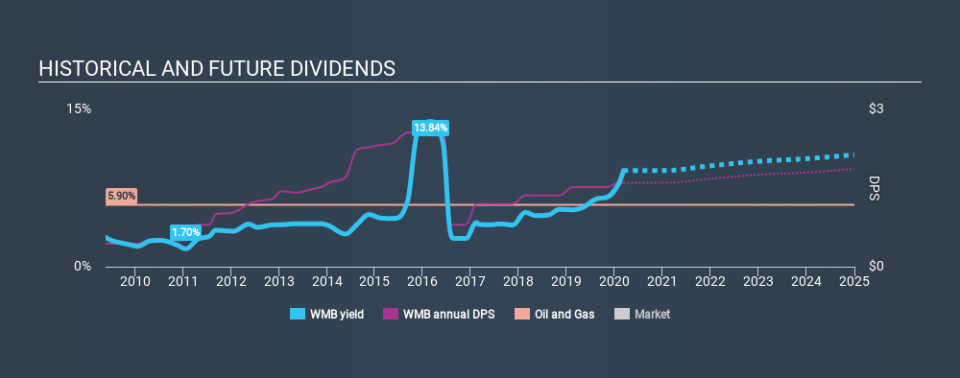Dividend Investors: Don't Be Too Quick To Buy The Williams Companies, Inc. (NYSE:WMB) For Its Upcoming Dividend

Readers hoping to buy The Williams Companies, Inc. (NYSE:WMB) for its dividend will need to make their move shortly, as the stock is about to trade ex-dividend. Investors can purchase shares before the 12th of March in order to be eligible for this dividend, which will be paid on the 30th of March.
Williams Companies's next dividend payment will be US$0.40 per share, on the back of last year when the company paid a total of US$1.60 to shareholders. Looking at the last 12 months of distributions, Williams Companies has a trailing yield of approximately 9.2% on its current stock price of $17.45. If you buy this business for its dividend, you should have an idea of whether Williams Companies's dividend is reliable and sustainable. As a result, readers should always check whether Williams Companies has been able to grow its dividends, or if the dividend might be cut.
See our latest analysis for Williams Companies
Dividends are typically paid out of company income, so if a company pays out more than it earned, its dividend is usually at a higher risk of being cut. Williams Companies paid out a disturbingly high 214% of its profit as dividends last year, which makes us concerned there's something we don't fully understand in the business. Yet cash flow is typically more important than profit for assessing dividend sustainability, so we should always check if the company generated enough cash to afford its dividend. Over the past year it paid out 119% of its free cash flow as dividends, which is uncomfortably high. We're curious about why the company paid out more cash than it generated last year, since this can be one of the early signs that a dividend may be unsustainable.
As Williams Companies's dividend was not well covered by either earnings or cash flow, we would be concerned that this dividend could be at risk over the long term.
Click here to see the company's payout ratio, plus analyst estimates of its future dividends.
Have Earnings And Dividends Been Growing?
Companies with falling earnings are riskier for dividend shareholders. Investors love dividends, so if earnings fall and the dividend is reduced, expect a stock to be sold off heavily at the same time. With that in mind, we're discomforted by Williams Companies's 25% per annum decline in earnings in the past five years. Such a sharp decline casts doubt on the future sustainability of the dividend.
Many investors will assess a company's dividend performance by evaluating how much the dividend payments have changed over time. In the past ten years, Williams Companies has increased its dividend at approximately 14% a year on average. That's intriguing, but the combination of growing dividends despite declining earnings can typically only be achieved by paying out a larger percentage of profits. Williams Companies is already paying out a high percentage of its income, so without earnings growth, we're doubtful of whether this dividend will grow much in the future.
Final Takeaway
Should investors buy Williams Companies for the upcoming dividend? Not only are earnings per share declining, but Williams Companies is paying out an uncomfortably high percentage of both its earnings and cashflow to shareholders as dividends. Unless there are grounds to believe a turnaround is imminent, this is one of the least attractive dividend stocks under this analysis. It's not an attractive combination from a dividend perspective, and we're inclined to pass on this one for the time being.
Although, if you're still interested in Williams Companies and want to know more, you'll find it very useful to know what risks this stock faces. Our analysis shows 5 warning signs for Williams Companies that we strongly recommend you have a look at before investing in the company.
A common investment mistake is buying the first interesting stock you see. Here you can find a list of promising dividend stocks with a greater than 2% yield and an upcoming dividend.
If you spot an error that warrants correction, please contact the editor at editorial-team@simplywallst.com. This article by Simply Wall St is general in nature. It does not constitute a recommendation to buy or sell any stock, and does not take account of your objectives, or your financial situation. Simply Wall St has no position in the stocks mentioned.
We aim to bring you long-term focused research analysis driven by fundamental data. Note that our analysis may not factor in the latest price-sensitive company announcements or qualitative material. Thank you for reading.

 Yahoo Finance
Yahoo Finance 
